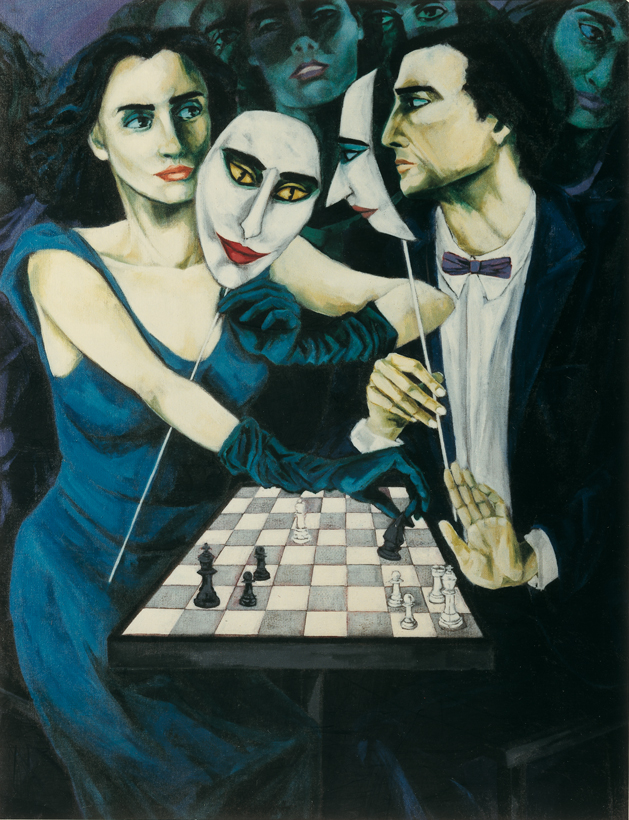
The other is stretching out as if giving command”.
#Checkmate painting retzsch full#
Much of what disgraces him he leaves behind him-one hand holds a full purse,

Into his side, but forgetful while displaying his splendid peacock’s tail how His head-which is tossed backwards-a feather crown, one arm insolently thrust Satan’s first Bishop is Pride “grave, moving stiffly forward, wearing on Satan’s other Castle is Anger described “like a turkeyĬock”. Satan’s Castles described merely as “sitting on an unhewn block of wood, with (other than the King and Queen) merely as “Officers”. Piece, preferring to identify all of Satan’s chess pieces that are not pawns The reason, they both fail to associate each named vice with a particular chess Were possibly admirers of great art but not necessarily chess players. Von MiltitzĪnd the author of the Our Monthly article Willingness to associate each “vice” with a specific chess piece. Peet’s analysis names the exact same vices and virtues described by Von Miltitzīut what is a bit more helpful, because Peet is a chess player, is his To view the full ColumbiaĬhess Chronicle article as it was posted by Miron click here. Pages 126 and 127 of the April, 1861 issue of the American magazine Chess Monthly. Retzsch’s chess pieces authored by one William Peet found previously on Miron not only offered further support for the Morphy anecdote butĪlso reminded the Chronicle’s readers of the description and symbolism of “Miron” was posted in the Decemissue (Volume III, Number 23-26). Submission to the editors of the Chronicle by someone identified only as Source of the Paul Morphy anecdote found on pages of the Columbia Chess Work (so accurately reproduced in bronze by Anthony W. Site offers no images of the other drawings.Īpparently James White’s plan to present “to the public” thoseĪdditional images created by another artist never materialized.įor a final analysis of the spiritual symbolism details found in Retzsch’s Likely penned by some other artist for that magazine. Such additional drawings, if they exist, were most There is no evidence weĬould discover on the internet of any scene executed by Retzsch entitled “The To show three separate scenes of “The Game of Life”.

Magazine he saw ten years previously around 1860 in the State of Vermont that purported In paragraph #1 of James White’s introductory remarks he refers to a White's introduction and the Von Miltitz's explanation can also be viewed on a single page by clicking here. Hit the page advance button > at the bottom of each page to advance the text. To view that explanation by Von Miltitz on-line as well as an introduction by Elder James White, Ellen G. White, founder of the Seventhĭay Adventist church. That analysis and explanation is found on the web site devoted to the writings of Ellen G. The spiritual symbolism detail of each of the chess pieces was offered by C. Thirty Three years later in 1870 (thirteen years after Retzsch’sĭeath in 1857) an even more thorough analysis and explanation of All the pieces are well set forth and it is evident that Satan'sĪrc (is) coming down in full force against those of his antagonist.” Humility,Īffection, and Innocence, are also taken but Religion, Truth, and Hope are Introducing prayers under the emblem of pawns inasmuch, as, if persevering andĮffectual, they may recover the vantage-ground which had been lost. There is no little beauty in the thought of


While Satan has secured several cherub forms, which are the Pawns of Man, andĪre symbolical of Prayer. Only pieces which he has taken are Anger, like a turkey-cock, and one Doubt The Cross Anger, &c the Pawns are Doubts and, alas for devoted man! The On his heart, and the other holding a dagger behind him Unbelief, trampling on Swine Pride, strutting about with a peacock's tail Falsehood, with one hand Pressing forward in front of all his officers are, Indolence, like a great The side of the demon, the King represents himself his Queen is Pleasure,


 0 kommentar(er)
0 kommentar(er)
